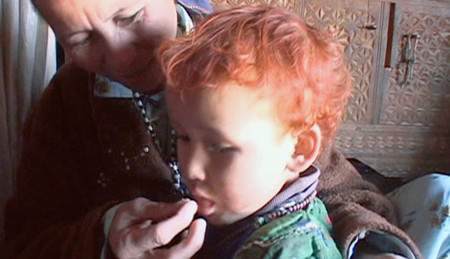fghanistan, known as one of the leading producers of drugs and causing health problems around the world, is experiencing the same tragedy today, despite an international effort to stamp the illegal trade out.

There are around one million Afghans suffering from drug addiction, of whom 13 percent are children and 20 percent are women, but only five percent of the drug users can get medical treatment, spokesperson of the Ministry of Public Health Kargar Noorughli told Xinhua. Aziza feeds a lump of pure opium to her 4-year-old son Omidullah. She has no education, no idea of the health risks involved in opium use, or that it is addictive. (Photo: CNN)
There are around one million Afghans suffering from drug addiction, of whom 13 percent are children and 20 percent are women, but only five percent of the drug users can get medical treatment, spokesperson of the Ministry of Public Health Kargar Noorughli told Xinhua on Monday.
According to him, about 50,000 of them use heroin, 150,000 use narcotics, more than 500,000 of them take hashish and around 180, 000 of them are taking relief drugs.
A survey on Drug Use in Afghanistan issued by the United Nations Office on Drugs and Crime (UNODC) on Jan. 20, said that rising opium prices may encourage Afghan farmers to plant more of the narcotic crop, and the poppy cultivation will spread this year, or even extend into provinces that had become poppy-free in recent years.
Over 90 percent of the world's supply of opium used to make heroin are provided by the Afghan producers, and Afghanistan is also the largest supplier of hashish, a potent cannabis resin.
According to the survey, the soaring prices are caused by market speculation that there will be shortages because of the opium blight which reduced production by half last year and the uncertainty among opium farmers regarding future cultivation due to the ongoing military operations in Afghanistan.
Poverty and high unemployment rate in Afghanistan are considered to be some of the major causes of the drug problems, which lead to crimes, loss of productivity in workplaces and a drug-related health crisis for the Afghan people.
"It is more than 9 years that I'm addicted to drugs. Poverty, unemployment, without education and easy access to drugs are the reasons for that, when I get out from here, I become addicted again due to unemployment,"said Ebrat Ullah, a drug addict from Kandahar province to receive treatment in the Nejat center.
There are more than one hundred patients receiving medical treatment to get rid of drugs in the Nejat center, west of Afghan capital Kabul, a nurse working for the Nejat center named Masoud told Xinhua.
"We have about 50 diagnosis and treatment centers for drug addicts across Afghanistan, including 20 supported by the government and NGOs. About seven to ten thousand addicts can receive treatment annually, but it makes just 5 percent, which is far from enough," said Kargar Noorughli.
"Many of them are taking drugs as a kind of self-medication against the hardships of life, and some of them had begun taking drugs as migrants or refugees in neighboring countries, especially in Iran," said Noorughli.
"In our opinion, if the government could be able to remove the cultivation and production of drugs in our country, we could get rid of drugs, otherwise impossible," said Dawood, who is under medical treatment in the Nejat center.
Twenty out of Afghanistan's 34 provinces, according to Afghan officials, are poppy-free and the effort to eradicate the menace in the remaining provinces is going on.
Experts say that, more opium cultivation suggests that the Taliban insurgency has spread across a wider region of the war- ridden country, which means there might be more conflicts and more poverty for the Afghan people in the coming years.
In this regard, according to experts, a continued effort to invest in alternative livelihood programmes in Afghanistan by international donors and the Afghan government is the key to the tackling of the drug problem, which is vital not only to the Afghan people, but also to the international community as a whole.
Editor: Deng Shasha



